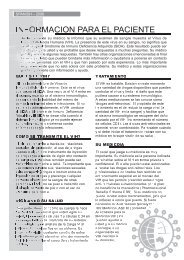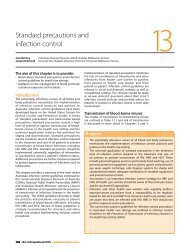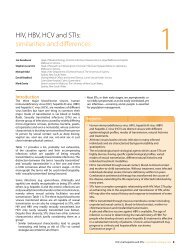B Positive – all you wanted to know about - ASHM
B Positive – all you wanted to know about - ASHM
B Positive – all you wanted to know about - ASHM
You also want an ePaper? Increase the reach of your titles
YUMPU automatically turns print PDFs into web optimized ePapers that Google loves.
7 Treatment of chronic hepatitis B virus infection<br />
and progressive liver damage. data from<br />
recent clinical trials have shown that prolonged<br />
control of viral replication may reduce the<br />
likelihood of liver decompensation and death.<br />
these results are also reflected in clinical<br />
experience, particularly in liver transplant<br />
centres, where the clinical recovery of patients<br />
with cHb after commencing antiviral therapy<br />
is well documented and the proportion of<br />
patients undergoing liver transplantation for<br />
cHb is decreasing. 2<br />
Loss of Hbsag is the only absolute endpoint of<br />
therapy in Hbeag-positive and Hbeag-negative<br />
chronic disease, but Hbsag seroconversion is<br />
uncommon and has not been used as a primary<br />
endpoint in most short-term clinical trials.<br />
an objective of antiviral therapy in Hbeagpositive<br />
patients is the loss of Hbeag and<br />
the development of anti-Hbe—the so-c<strong>all</strong>ed<br />
eag seroconversion. Hbeag seroconversion<br />
is infrequent, although rates increase with<br />
prolonged antiviral therapy. sustained<br />
Hbeag seroconversion indicates that antiviral<br />
therapy may be discontinued after a period<br />
of consolidation (six <strong>to</strong> nine months) and that<br />
viral suppression may be maintained even<br />
after the cessation of treatment. in some cases,<br />
however, the Hbeag loss is not durable and<br />
sero-reversion may occur. thus, <strong>all</strong> patients<br />
require careful ongoing moni<strong>to</strong>ring.<br />
in the majority of patients with Hbeag-positive<br />
disease, Hbeag seroconversion does not occur<br />
and thus many years of therapy are required.<br />
the emergence of drug resistance in these<br />
patients can become a significant therapeutic<br />
ch<strong>all</strong>enge. 1<br />
therapy for Hbeag-negative patients is more<br />
difficult <strong>to</strong> assess, as Hbeag seroconversion<br />
cannot be used as an endpoint. the suppression<br />
of HbV dna and the normalisation of aLt levels<br />
are markers of a virological and biochemical<br />
response, but both usu<strong>all</strong>y rebound shortly<br />
after therapy is ceased. in general, the<br />
decision <strong>to</strong> commence a patient with Hbeagnegative<br />
disease on a nucleoside analogue is<br />
a commitment <strong>to</strong> indefinite therapy. Problems<br />
with viral resistance may emerge, although<br />
58 b <strong>Positive</strong> <strong>–</strong> <strong>all</strong> <strong>you</strong> <strong>wanted</strong> <strong>to</strong> <strong>know</strong> <strong>about</strong> hepatitis b: a guide for primary care providers<br />
the rates of resistance vary with the chosen<br />
antiviral agent.<br />
Indications for antiviral therapy<br />
the decision <strong>to</strong> commence antiviral therapy<br />
is based upon a number of fac<strong>to</strong>rs, including<br />
the patient’s age, the Hbeag status, the<br />
serum HbV dna concentration, aLt levels,<br />
and the risk of Hcc. in australia, liver biopsy<br />
remains a compulsory requirement for the<br />
reimbursement of therapy (unless the patient<br />
has an underlying coagulation disorder) and<br />
the his<strong>to</strong>logical severity of the underlying<br />
liver disease is an important element of the<br />
decision-making process <strong>to</strong> initiate treatment.<br />
When choosing the most appropriate anti-<br />
HbV therapy, it is important <strong>to</strong> consider the<br />
advantages and disadvantages of each therapy<br />
based on the available clinical evidence. the<br />
choice of therapy must take in<strong>to</strong> account the<br />
drug’s efficacy, safety, chance of achieving<br />
desired endpoints, anticipated duration of<br />
therapy and the likelihood of developing<br />
resistance. the likelihood of patient adherence<br />
<strong>to</strong> therapy regimens should be considered,<br />
as non-adherence may be associated with<br />
significant flares in disease activity.<br />
HBeAg-positive patients<br />
Hbeag-positive patients with an elevated<br />
serum aLt greater than two times the upper<br />
limit of normal (uLn) and a serum HbV dna<br />
level of greater than 20,000 iu/mL should be<br />
considered for antiviral therapy. under current<br />
Pbs recommendations, these patients require<br />
a liver biopsy demonstrating his<strong>to</strong>logical<br />
evidence of cHb. 3<br />
in general, Hbeag-positive patients with a<br />
serum HbV dna level of less than 20,000 iu/mL<br />
are not recommended for therapy, because the<br />
vast majority of these patients will have inactive<br />
disease and a normal aLt level. the HbV dna<br />
level and the necroinflamma<strong>to</strong>ry activity of the<br />
liver disease are subject <strong>to</strong> significant variability<br />
and these patients should be moni<strong>to</strong>red <strong>to</strong><br />
ensure constant levels of HbV dna and the<br />
persistence of a normal aLt level. at present,<br />
an annual HbV dna measurement will be<br />
reimbursed by the australian Pbs, although it






